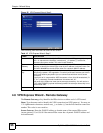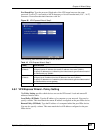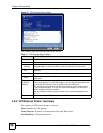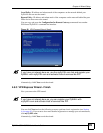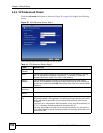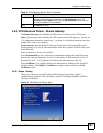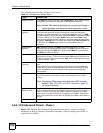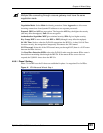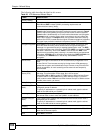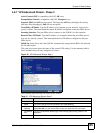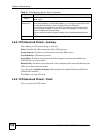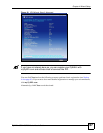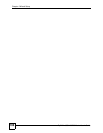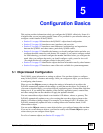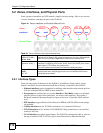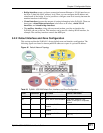
Chapter 4 Wizard Setup
ZyWALL USG 100/200 Series User’s Guide
104
The following table describes the labels in this screen.
Table 20 VPN Advanced Wizard: Step 4
LABEL DESCRIPTION
Phase 2 Setting
Active Protocol Select the security protocols used for an SA.
Both AH and ESP increase ZyWALL processing requirements and
communications latency (delay).
Encapsulation Tunnel is compatible with NAT, Transport is not.
Tunnel mode encapsulates the entire IP packet to transmit it securely. Tunnel
mode is required for gateway services to provide access to internal systems.
Tunnel mode is fundamentally an IP tunnel with authentication and encryption.
Transport mode is used to protect upper layer protocols and only affects the
data in the IP packet. In Transport mode, the IP packet contains the security
protocol (AH or ESP) located after the original IP header and options, but before
any upper layer protocols contained in the packet (such as TCP and UDP).
Encryption Algorithm When DES is used for data communications, both sender and receiver must
know the same secret key, which can be used to encrypt and decrypt the
message or to generate and verify a message authentication code. The DES
encryption algorithm uses a 56-bit key. Triple DES (3DES) is a variation on DES
that uses a 168-bit key. As a result, 3DES is more secure than DES. It also
requires more processing power, resulting in increased latency and decreased
throughput. AES128 uses a 128-bit key and is faster than 3DES. AES192 uses
a 192-bit key and AES256 uses a 256-bit key. Select Null to have no
encryption.
SA Life Time Define the length of time before an IKE SA automatically renegotiates in this
field.
A short SA Life Time increases security by forcing the two VPN gateways to
update the encryption and authentication keys. However, every time the VPN
tunnel renegotiates, all users accessing remote resources are temporarily
disconnected.
Perfect Forward
Secret (PFS)
Perfect Forward Secret (PFS) is disabled (None) by default in phase 2 IPSec
SA setup. This allows faster IPSec setup, but is not so secure.
Select DH1, DH2 or DH5 to enable PFS. DH1 refers to Diffie-Hellman Group 1
a 768 bit random number. DH2 refers to Diffie-Hellman Group 2 a 1024 bit
(1Kb) random number. DH5 refers to Diffie-Hellman Group 5 a 1536 bit random
number (more secure, yet slower).
Policy Setting
Local Policy (IP/
Mask)
Type a static local IP address that corresponds to the remote IPSec router's
configured remote IP address.
To specify IP addresses on a network by their subnet mask, type the subnet
mask of the LAN behind your ZyWALL.
Incoming Interface Select an interface from the drop-down list box to have packets encrypted by
the remote IPSec router to enter the ZyWALL via this interface.
Remote Policy (IP/
Mask)
Type a static local IP address that corresponds to the remote IPSec router's
configured local IP address.
To specify IP addresses on a network by their subnet mask, type the subnet
mask of the LAN behind the remote gateway.
Property
Nailed-Up Select this if you want the ZyWALL to automatically renegotiate the IPSec SA
when the SA life time expires.
Next Click Next to continue.



